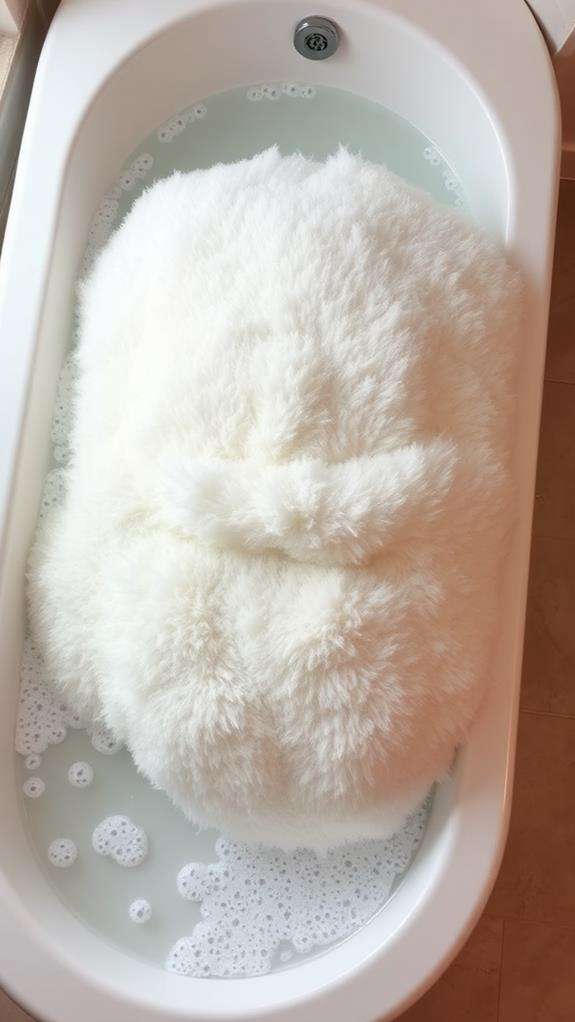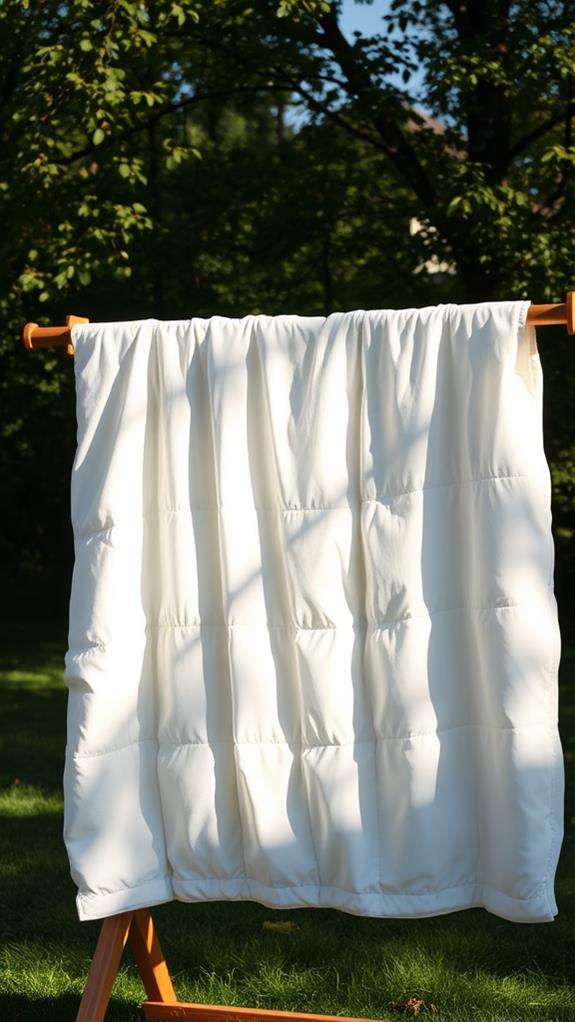How to Clean Comforter Too Big for Washer
To clean a comforter that's too big for your washer, you'll need to use your bathtub as an alternative washing station. First, verify your tub is clean and fill it with lukewarm water, adding about 1 teaspoon of mild detergent per gallon. Submerge your comforter completely and gently knead it for thorough cleaning. Drain the soapy water and rinse repeatedly with clean water until no soap remains. Once rinsed, carefully press out excess water and hang the comforter outdoors in sunlight for 24 hours to dry completely. For best results, you'll want to understand the specific maintenance techniques that can extend the life of your freshly cleaned comforter.
This post may contain affiliate links. If you make a purchase through these links, I may earn a commission at no additional cost to you. Additionally, portions of this post may be generated using artificial intelligence (AI) technology. While we strive for accuracy, please be aware that AI-generated content may not always be perfect and should be fact-checked when necessary.
The Spatula Scoops
- Fill a clean bathtub with lukewarm water, add mild detergent, and gently knead the comforter to ensure thorough cleaning.
- Rinse the comforter repeatedly with cool water until no soap remains, then gently press out excess water.
- Hang the comforter outdoors in sunlight for 24 hours, ensuring complete drying to prevent mold and mildew.
- For spot cleaning, treat stains immediately using a gentle detergent solution and let sit for 30 minutes before rinsing.
- Between deep cleans, shake the comforter daily and air it out bi-weekly in sunlight to maintain freshness.
Signs Your Comforter Needs Cleaning

From the subtle signs to the obvious indicators, recognizing when your comforter needs cleaning can help maintain a healthy sleeping environment. When you notice an unpleasant odor emanating from your bedding, it's often a warning sign of mold and mildew growth caused by trapped moisture, which requires immediate attention to prevent further issues.
You'll want to inspect your comforter regularly for visible stains, spots, or spills that can compromise both its appearance and hygiene. If you're noticing excessive dust accumulation on the surface, or if you're aware of allergens like dust mites and pet dander collecting in the fabric, it's definitely time for a thorough cleaning. Pay particular attention if you're experiencing increased allergic reactions or respiratory problems while sleeping, as these symptoms often indicate your comforter needs revitalization.
Don't forget to check your comforter's care label before cleaning, as it provides essential instructions for proper maintenance. When you observe any combination of these signs – unpleasant odors, visible dirt, or increased allergy symptoms – it's time to take action and clean your comforter, even if it seems challenging due to its size.
Bathtub Washing Method

When your comforter is too large for your washing machine, the bathtub method offers a practical solution for deep cleaning. To wash a comforter without a washer, you'll need to prepare your bathtub by ensuring the drain is properly sealed and filling it with warm water.
| Step | Duration | Water Type | Action Required |
|---|---|---|---|
| Preparation | 5 min | Warm | Add 1 tsp detergent per gallon |
| Washing | 10-15 min | Warm | Knead and swirl gently |
| Rinsing | 10 min | Cool | Remove soap residue |
| Drying | 24 hours | None | Hang outdoors in sunlight |
To clean a comforter without hassle, mix the detergent thoroughly in the water before you submerge the comforter. Once it's fully submerged, gently work the soap through the fabric using your hands, paying special attention to any stained areas. After washing, drain the soapy water and rinse the comforter with cool, clean water until no soap remains. For complete drying, hang your comforter outdoors on a sunny day. You'll want to allow a full 24 hours for it to dry thoroughly, which prevents any mildew from forming in the filling.
Preparing Your Work Space

Before tackling your oversized comforter, you'll need to clear and clean your work area thoroughly, removing any items from the bathtub and wiping down surfaces to prevent debris from sticking to your comforter. Check that your bathtub drain properly seals and can hold water throughout the entire washing process, as you'll need to maintain consistent water levels for effective cleaning. Gather your supplies within arm's reach, including a gentle detergent, clean towels, and any spot-treatment products you might need for stubborn stains.
Clear Your Work Area
Getting started with cleaning your comforter requires a well-prepared workspace. Before you begin the washing process, you'll need to make certain your work area is completely clear of any unnecessary items that might get in your way or become wet during cleaning.
Start by thoroughly cleaning your bathtub, removing any soap residue, hair, or dirt that could transfer onto your comforter. Once you've done that, place absorbent towels or mats around the tub to catch any excess water that might splash out. You'll want to confirm you have all your supplies on hand and within easy reach, including your detergent, stain removers for pre-treatment, and any additional cleaning tools you might need.
Consider the space you'll need for air drying your comforter when you're finished washing it. Clear that area in advance, setting up a drying rack or clothesline if necessary. Make sure you've got proper lighting in your work area so you can spot any stains that need special attention. Finally, seal the drain with a secure plug to prevent water loss during the cleaning process.
Check Bathtub Drainage
Proper drainage is essential for successfully washing your comforter in the bathtub. Before you begin the washing process, you'll need to check your bathtub's drainage system thoroughly to prevent any leaks or unexpected water loss. A well-maintained drain guarantees an effective washing environment for your comforter, allowing you to control the water level throughout the cleaning process.
Make certain to perform these critical drainage checks before proceeding:
- Inspect the drain stopper for proper sealing and replace it if necessary
- Clear any hair or debris that might be blocking the drain
- Test the drain plug by filling the tub with a few inches of water
- Look for cracks or damage around the drain area that could cause leaks
- Confirm the overflow drain is properly sealed to maintain water levels
If your drain stopper isn't creating a tight seal, you can use a rubber drain cover or place a clean towel over the drain for additional protection. Remember to clean the bathtub surface thoroughly before starting, as any residue could transfer to your comforter during washing. Once you've confirmed proper drainage control, you'll be ready to proceed with washing your comforter.
Gather Essential Supplies
To guarantee a smooth comforter-cleaning process, you'll need to collect several essential supplies and organize your workspace. First, locate a clean bathtub or large plastic container that's spacious enough to fully submerge your comforter. You'll also need to establish that your drain plug functions properly to prevent water from escaping during the washing process.
Choose a high-quality liquid laundry detergent rather than powder, as liquid formulas dissolve more effectively in cold water. Keep a clean, absorbent towel nearby to help manage excess water during washing and rinsing stages. This will come in handy when you're moving the wet comforter or need to soak up spills.
Before you begin, identify an appropriate drying area that's well-ventilated and spacious enough to accommodate your comforter's full size. If you're planning to dry indoors, clear a large space where the comforter can lay flat without touching the floor. For outdoor drying, select a clean, sturdy clothesline or drying rack that can support your comforter's weight when wet. Remember to check weather conditions if you're planning to dry outside.
Choosing The Right Detergent

Selecting the right detergent plays an essential role in keeping your comforter clean and protected. When dealing with an oversized comforter that's too big for your washer, you'll want to be particularly careful about your detergent choice, as improper cleaning agents can damage your bedding. For hand washing, use approximately one teaspoon of mild detergent per gallon of water to guarantee thorough cleaning without leaving behind residue. Additionally, using natural cleaning agents like non-chlorine detergents for white fabrics can enhance the cleaning process while safeguarding your comforter's material.
To make your detergent selection process easier, here are key considerations to keep in mind:
- Choose natural-based or mild detergents specifically designed for delicate fabrics
- Confirm the cleaning solution is compatible with your comforter's material type
- Select biodegradable options to minimize environmental impact
- Avoid bleach and harsh chemicals that can break down fibers
- Use the recommended amount to prevent soap buildup
When selecting your detergent, check the care label on your comforter first to confirm any specific cleaning requirements. If you're unsure about compatibility, opt for a gentle, natural-based cleaner that's designed for delicate fabrics. Remember that using too much detergent can be just as harmful as using the wrong type, so measure carefully and follow the manufacturer's guidelines.
Hand Washing Steps

Once you've selected the right detergent, hand washing your comforter requires careful attention to detail and a methodical approach. Start by preparing your bathtub, making certain it's thoroughly clean and the drain is properly plugged. Fill it with lukewarm water, as this temperature helps dissolve the detergent while being gentle on your comforter's fibers.
As you're filling the tub, add your detergent into the water, using approximately one teaspoon per gallon to create a balanced soapy water solution. Submerge your comforter completely, and use your hands to wash the comforter without it getting tangled or bunched up. Gently knead and manipulate the fabric to make sure the cleaning solution reaches all areas.
Once you've thoroughly cleaned the comforter, drain the soapy water and refill with cool water to rinse out all detergent residue. You'll need to repeat this rinsing process until the water runs clear. After the final rinse, carefully squeeze out excess water without wringing or twisting. Finally, hang the comforter outdoors in direct sunlight to air dry completely, which typically takes about 24 hours, depending on weather conditions.
Drying Your Large Comforter

After washing your comforter, proper drying is essential to maintain its quality and prevent mold growth. If you're using a local laundromat, choose a large-capacity dryer and set it to low heat or air-dry to protect the fabric and filling. Your bulky comforter will need between 1-3 hours of drying time, depending on its size and material.
To guarantee your comforter dries evenly and maintains its fluffiness, follow these important steps:
- Add clean tennis balls or dryer balls to prevent clumping and help redistribute the filling
- Check and fluff the comforter every 30-45 minutes during the drying cycle
- Continue drying until the comforter is thoroughly dry, with no damp spots
- Test for moisture by feeling deep within the corners and middle sections
- Remove promptly once completely dry to prevent wrinkles
If you can't access a dryer, hang the comforter outdoors in a well-ventilated area on a sunny day. This natural drying method typically takes up to 24 hours, so verify good weather conditions before starting. Remember to position the comforter where it can receive maximum airflow and sunlight for the best drying results.
Maintaining Between Deep Cleans

Between deep cleanings, you'll need to tackle any spills or marks on your comforter right away with a gentle spot-cleaning solution and a clean white cloth. To protect your comforter from potential stains, consider using a BPA-free container for storing snacks or meals nearby. Daily maintenance should include giving your comforter a good shake when making your bed, which helps redistribute the filling and prevent clumping. To keep your comforter fresh and fluffy, you can pop it in the dryer on air-fluff for 15 minutes every few weeks, using dryer balls to maintain its loft and eliminate any musty odors.
Regular Spot Treatment Tips
Tackling stains promptly can save your comforter from permanent damage and extend its life between deep cleanings. When you spot clean your comforter, you'll want to use a gentle detergent mixed with water to effectively clean any soiled areas. Don't wait until stains set in – immediate attention is vital for successful stain removal.
To properly care for your comforter between deep cleanings, incorporate these essential spot treatment practices:
- Mix a gentle detergent with water and apply directly to stains, letting it sit for 30 minutes before rinsing
- Use a clean cloth to dab the stained area gently, avoiding aggressive scrubbing that could damage fibers
- Create a paste using baking soda and water for tough oil or food stains
- Fluff your comforter regularly to prevent dirt from settling and maintain even filling distribution
- Take advantage of sunny days by airing out your comforter outdoors to reduce allergens
Remember to test any cleaning solution on a small, inconspicuous area first. While spot cleaning helps maintain your comforter's appearance, you'll still need periodic deep cleaning for best results. Consistent comforters care through regular spot treatment will greatly extend the time between major cleanings.
Quick Freshening Methods
Your comforter's freshness doesn't have to wait for deep cleaning days. With quick freshening methods, you'll maintain good hygiene and extend the life of your bedding between thorough cleanings. To protect your comforter and prevent mustiness, incorporate these simple maintenance techniques into your routine.
| Time | Action | Benefit |
|---|---|---|
| Daily | Fluff vigorously | Maintains shape and distributes filling |
| Weekly | Change duvet cover | Protects from skin oils and dirt |
| Bi-weekly | Air out in sunlight | Eliminates odors and moisture |
| Monthly | Rotate position | Prevents wear patterns |
When spot cleaning becomes necessary, don't wait – tackle stains immediately with a gentle soap solution. You'll want to dab, not rub, to preserve the fabric's integrity. If you're using a duvet cover (which you should), washing it weekly creates a protective barrier that keeps your comforter cleaner longer. Remember to shake out your comforter each morning when making your bed, as this simple habit helps maintain its loft. On sunny days, take advantage of natural freshening by hanging your comforter outside for a few hours, allowing fresh air to circulate through the filling.
Frequently Asked Questions
What Do I Do if My Comforter Is Too Big for My Washer?
You've got two effective options for cleaning your oversized comforter. First, you can hand wash it in your bathtub using warm water and mild detergent – just make sure to seal the drain first. Alternatively, take it to a laundromat with large-capacity washers (at least 5.0 cu. ft.). Before starting either method, check the care label for specific instructions. After washing, air dry your comforter in a well-ventilated area for 1-3 hours.
How Do You Wash an Oversized Comforter?
You can wash an oversized comforter by hand in your bathtub with warm water and mild detergent. Fill the tub, add detergent, and fully submerge the comforter, gently agitating to guarantee thorough cleaning. Alternatively, visit a laundromat with commercial-sized washers that'll accommodate your comforter's size. Before washing, always check the care label, as some materials may require dry cleaning. After washing, air dry in a well-ventilated space to maintain fluffiness.
Can You Wash a King-Size Comforter in a 4.5 Cu Ft Washer?
While you might be tempted to squeeze your king-size comforter into your 4.5 cu ft washer, you shouldn't. A king comforter needs at least 5.0 cu ft for proper cleaning and agitation. If you try to wash it in a smaller machine, you'll risk damaging both your washer and comforter. Instead, you'll want to take it to a laundromat with large-capacity machines or consider professional cleaning services for the best results.
How to Wash a Duvet That Won't Fit in the Washing Machine?
When your duvet's too big for your washing machine, you've got two practical options. You can hand wash it in your bathtub using warm water and mild detergent, gently kneading it to guarantee thorough cleaning. If that's not feasible, head to a laundromat with large-capacity washers. Remember to check the care label first, and always allow your duvet to dry completely in a well-ventilated area before using it again.





